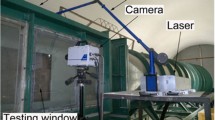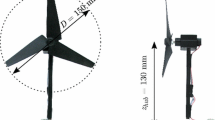Abstract
Wind tunnel experiments of the wake characteristics of a two-blade wind turbine, in the downstream region of 0<x/R<10, have been carried out. With the help of the time resolved particle image velocimetry (TRPIV), flow properties such as the vortex structure, average velocity, fluctuations velocities and Reynolds stresses are obtained at different tip speed ratios (TSR). It is found that the wind turbine wake flow can be divided into velocity deficit region, velocity remained region and velocity increased region, with generally higher velocity deficit compared with a three-blade wind turbine wake. Once a blade rotates to the reference 0° plane, the tip vortices generate, shed and move downstream with the intensity gradually decreased. The leapfrogging phenomenon of tip vortices caused by the force interaction of adjacent vortices is found and more apparent in the far wake region. The axial fluctuation velocity is larger than radial fluctuation velocity at the blade root region, and the turbulent kinetic energy shares the similar trend as the axial fluctuation velocity. The axial normalized Reynolds normal stress is much larger than the radial normalized Reynolds normal stress and Reynolds shear stress at the blade root region. As the TSR increases, the radial location where the peak axial normalized Reynolds normal stress \(\overline{u'u'}\) / U 2 and axial fluctuation velocity appear descends in the radial direction.
Similar content being viewed by others
References
National Energy Administration. Development of China’s wind power industry in 2015. 2016
The Global Wind Energy Council. Report on the development of global wind power in 2014. 2015
Vermeer L J, Sørensen J N, Crespo A. Wind turbine wake aerodynamics. Prog Aerosp Sci, 2003, 39: 467–510
Bartl J, Pierella F, Sætrana L. Wake measurements behind an array of two model wind turbines. Energy Procedia, 2012, 24: 305–312
Abdelsalam A M, Boopathi K, Gomathinayagam S, et al. Experimental and numerical studies on the wake behavior of a horizontal axis wind turbine. J Wind Eng Ind Aerodyn, 2014, 128: 54–65
Wang J, Qiu K. Time resolved particle image velocimetry experimental study of the near wake characteristics of a horizontal axis wind turbine. JZUS-A, 2015, 16: 586–595
Lignarolo L E M, Ragni D, Krishnaswami C, et al. Experimental analysis of the wake of a horizontal-axis wind-turbine model. Renew Energy, 2014, 70: 31–46
Toloui M, Chamorro L P, Hong J. Detection of tip-vortex signatures behind a 2.5 MW wind turbine. J Wind Eng Ind Aerodyn, 2015, 143: 105–112
Chu C R, Chiang P H. Turbulence effects on the wake flow and power production of a horizontal-axis wind turbine. J Wind Eng Ind Aerodyn, 2014, 124: 82–89
Adaramola M S, Krogstad P Å. Experimental investigation of wake effects on wind turbine performance. Renew Energy, 2011, 36: 2078–2086
Xie W, Zeng P, Lei L. Wind tunnel experiments for innovative pitch regulated blade of horizontal axis wind turbine. Energy, 2015, 91: 1070–1080
Morandi B, Di Felice F, Costanzo M, et al. Experimental investigation of the near wake of a horizontal axis tidal current turbine. Int J Mar Energy, 2016, 14: 229–247
Kim S H, Shin H K, Joo Y C, et al. A study of the wake effects on the wind characteristics and fatigue loads for the turbines in a wind farm. Renew Energy, 2015, 74: 536–543
Chen X, Qin Z W, Yang K, et al. Numerical analysis and experimental investigation of wind turbine blades with innovative features: Structural response and characteristics. Sci China Tech Sci, 2015, 58: 1–8
Wang D, Chen Y S, Hao Z F, et al. Bifurcation analysis for vibrations of a turbine blade excited by air flows. Sci China Tech Sci, 2016, 59: 1217–1231
Ivanell S, Mikkelsen R, Sørensen J N, et al. Stability analysis of the tip vortices of a wind turbine. Wind Energy, 2010, 13: 705–715
Chen Q H, Xu L. SPIV analysis of correlation of tip vortex and wake flow of horizontal axial wind turbine. Acta Energy Solaris Sin, 2016, 37: 297–302
Lee H M, Wu Y. A Tomo-PIV study of the effects of freestream turbulence on stall delay of the blade of a horizontal-axis wind turbine. Wind Energy, 2015, 18: 1185–1205
Mun L H, Wu Y H. Experimental study of rotational effect on stalling. Chin Phys Lett, 2013, 30: 064703
Akay B, Ragni D, Simão Ferreira C J, et al. Experimental investigation of the root flow in a horizontal axis wind turbine. Wind Energy, 2014, 17: 1093–1109
Lee H M, Wu Y. An experimental study of stall delay on the blade of a horizontal-axis wind turbine using tomographic particle image velocimetry. J Wind Eng Ind Aerodyn, 2013, 123: 56–68
Jin Z, Dong Q, Yang Z. A stereoscopic PIV study of the effect of rime ice on the vortex structures in the wake of a wind turbine. J Wind Eng Ind Aerodyn, 2014, 134: 139–148
Liu X, Bao Y, Li Z, et al. Analysis of turbulence structure in the stirred tank with a deep hollow blade disc turbine by time-resolved PIV. Chin J Chem Eng, 2010, 18: 588–599
Vergine F, Maddalena L. Stereoscopic particle image velocimetry measurements of supersonic, turbulent, and interacting streamwise vortices: Challenges and application. Prog Aerosp Sci, 2014, 66: 1–16
Stafford J, Walsh E, Egan V. A statistical analysis for time-averaged turbulent and fluctuating flow fields using particle image velocimetry. Flow Meas Instrum, 2012, 26: 1–9
Prasad A K, Adrian R J, Landreth C C, et al. Effect of resolution on the speed and accuracy of particle image velocimetry interrogation. Exp Fluids, 1992, 13: 105–116
Adrian R J, Westerweel J. Particle Image Velocimetry. Cambridge: Cambridge University Press, 2011
Tang Z Q, Jiang N. Statistical scale of hairpin packets in the later stage of bypass transition induced by cylinder wake. Exp Fluids, 2012, 53: 343–351
Christensen K T, Adrian R J. Measurement of instantaneous Eulerian acceleration fields by particle image accelerometry: Method and accuracy. Exp Fluids, 2002, 33: 759–769
Author information
Authors and Affiliations
Corresponding author
Rights and permissions
About this article
Cite this article
Zhang, L., Xing, J., Wang, J. et al. Experimental study of the wake characteristics of a two-blade horizontal axis wind turbine by time-resolved PIV. Sci. China Technol. Sci. 60, 593–601 (2017). https://doi.org/10.1007/s11431-016-0558-1
Received:
Accepted:
Published:
Issue Date:
DOI: https://doi.org/10.1007/s11431-016-0558-1




